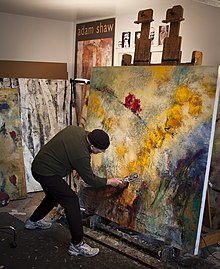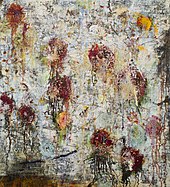
Clyfford Still was an American painter, and one of the leading figures in the first generation of Abstract Expressionists, who developed a new, powerful approach to painting in the years immediately following World War II. Still has been credited with laying the groundwork for the movement, as his shift from representational to abstract painting occurred between 1938 and 1942, earlier than his colleagues like Jackson Pollock and Mark Rothko, who continued to paint in figurative-surrealist styles well into the 1940s.

Francisco Manuel Oller y Cestero was a Puerto Rican painter, the only Latin American painter to have played a role in the development of Impressionism. One of the most distinguished transatlantic painters of his day, Oller helped transform painting in the Caribbean.
Ruth Doerschuk Dicker was a California painter of landscapes. She primarily lived in New York City, Palo Alto, and Santa Rosa.

Spanish art has been an important contributor to Western art and Spain has produced many famous and influential artists including Velázquez, Goya and Picasso. Spanish art was particularly influenced by France and Italy during the Baroque and Neoclassical periods, but Spanish art has often had very distinctive characteristics, partly explained by the Moorish heritage in Spain, and through the political and cultural climate in Spain during the Counter-Reformation and the subsequent eclipse of Spanish power under the Bourbon dynasty.
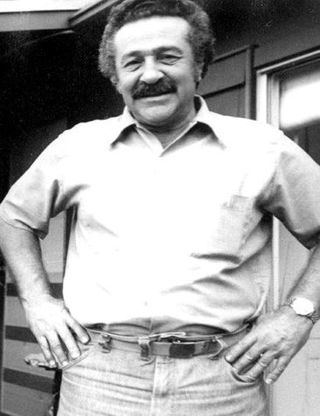
Nathan Oliveira was an American painter, printmaker, and sculptor, born in Oakland, California to immigrant Portuguese parents. Since the late 1950s, Oliveira has been the subject of nearly one hundred solo exhibitions, in addition to having been included in hundreds of group exhibitions in important museums and galleries worldwide. He taught studio art for several decades in California, beginning in the early 1950s, when he taught at the California College of Arts and Crafts in Oakland. After serving as a Visiting Artist at several universities, he became a Professor of Studio Art at Stanford University.
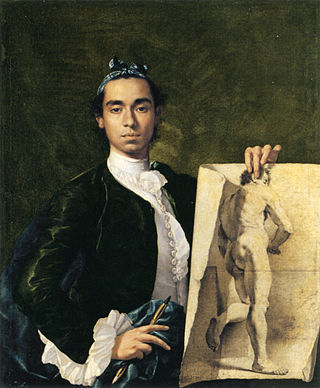
Luis Egidio Meléndez (1716–1780) was a Spanish painter. Though he received little acclaim during his lifetime and died in poverty, Meléndez is recognized as the greatest Spanish still-life painter of the 18th century. His mastery of composition and light, and remarkable ability to convey the volume and texture of individual objects enabled him to transform the most mundane of kitchen fare into powerful images.
Joe Goode, is an American visual artist, known for his pop art paintings. Goode made a name for himself in Los Angeles, California, through his cloud imagery and milk bottle paintings which were associated with the Pop Art movement. The artist is also closely associated with Light and Space, a West Coast art movement of the early 1960s. He resides in Los Angeles, California.
Roy De Forest was an American painter, sculptor, and teacher. He was involved in both the Funk art and Nut art movements in the Bay Area of California. De Forest's art is known for its quirky and comical fantasy lands filled with bright colors and creatures, most commonly dogs.
James Edward Grant was an American painter and sculptor active from the late 1950s into the early 1970s. Best known for his sculptural work in plastics, this work by no means defined him but was rather a natural endpoint of an exploration into increased dimensionality—starting from abstract canvases, moving through collages and bas-reliefs until the work finally came off the wall in sculptural form.
Julius Hatofsky was an American painter.

The terms California Impressionism and California Plein-Air Painting describe the large movement of 20th century artists who worked out of doors, directly from nature in California, United States. Their work became popular in the San Francisco Bay Area and Southern California in the first three decades after the turn of the 20th century. Considered to be a regional variation on American Impressionism, the California Impressionists are a subset of the California Plein-Air School.
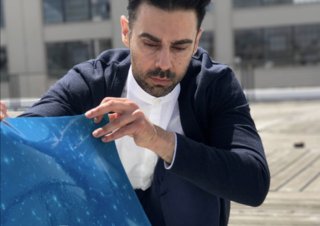
Ala Ebtekar is an American contemporary visual artist, of Iranian descent. He is known for his work in painting, drawing, illumination, and installation. His work frequently orchestrates various orbits and cadences of time, bringing forth sculptural and photographic possibilities of the universe, and time, gazing back at us.
Frederick Spratt was an American artist and educator, best known for his color theory paintings.
David Simpson is an American abstract painter and educator, who lives in Berkeley, California. His work is associated with the minimalist, monochrome, and color field movements. Since 1958, Simpson has had more than 70 solo exhibitions of his paintings in galleries and museums worldwide. His paintings have been included in hundreds of group exhibitions throughout the United States and Europe. During the early 1960s Simpson was included in two seminal group exhibitions: Americans 1963 at the Museum of Modern Art in New York curated by Dorothy Canning Miller and Post-Painterly Abstraction curated by Clement Greenberg in 1964; that traveled to the Los Angeles County Museum of Art the Walker Art Center and the Art Gallery of Toronto.
Margaret Rinkovsky is an American landscape painter.
John Zurier is an American abstract painter, known for his minimal, near-monochrome paintings. His work has shown across the United States as well as in Europe and Japan. He has worked in Reykjavik, Iceland and Berkeley, California. Zurier lives in Berkeley, California.

Jack Hooper was an American painter, muralist, sculptor, printmaker and art educator. Hooper was a major figure on the Southern California art scene, belonging to that generation of Los Angeles painters who matured during the late 1950s and the 1960s, painters such as John Altoon, Sam Amato, Robert Irwin, Lee Mullican, William Brice and Billy Al Bengston. He was an innovator in the use of new materials, most importantly plastic in art. He is known for abstract expressionist, mural and figurative painting. Hooper has exhibited in art museums and galleries nationally and internationally including solo shows in Europe, Mexico and the United States. Modeling renown UCLA art professor and figurative artist, Jan Stussy, the last 20 years of his life were spent in rural Mexico, where he drew and painted every single day until his death.
Richard Shaw is an American ceramicist and professor known for his trompe-l'œil style. A term often associated with paintings, referring to the illusion that a two-dimensional surface is three-dimensional. In Shaw's work, it refers to his replication of everyday objects in porcelain. He then glazes these components and groups them in unexpected and even jarring combinations. Interested in how objects can reflect a person or identity, Shaw poses questions regarding the relationship between appearances and reality.

Sydney Jones Yard was a 19th century American watercolor artist, known as one of the region's great painters, and the first professional artist to settle in the new community of Carmel-by-the-Sea, California.
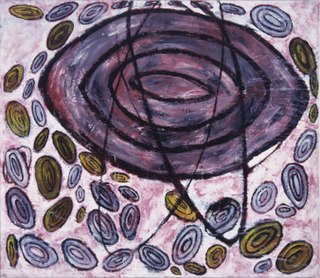
Joan Moment is an American painter based in Northern California. She emerged from the 1960s Northern California Funk art movement and gained attention when the Whitney Museum of American Art Curator Marcia Tucker selected her for the 1973 Biennial and for a solo exhibition at the Whitney in 1974. Moment is known for process-oriented paintings that employ non-traditional materials and techniques evoking vital energies conveyed through archetypal iconography. Though briefly aligned with Funk—which was often defined by ribald humor and irreverence toward art-world pretensions—her work diverged by the mid-1970s, fusing abstraction and figuration in paintings that writers compared to prehistoric and tribal art. Critic Victoria Dalkey wrote that Moment's methods combined chance and improvisation to address "forces embodied in a universe too large for us to comprehend, as well as the ... fragility and transience of the material world."

